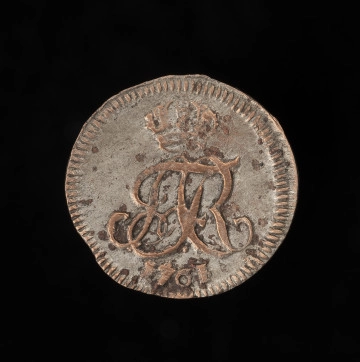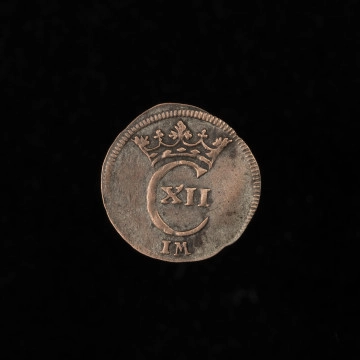
Schilling (1/48 of a thaler)
1761
National Museum in Szczecin
Part of the collection: Pomeranian coins
The history of minting in the eastern part of West Pomerania is linked to the Brandenburg and later Prussian monetary system. Szczecin, after its incorporation into Prussia in 1720, became the capital of the province of Pomerania. In 1753, a mint was set up in the fifth wing of the Castle of the Pomeranian Dukes and small denominations were minted under the stamp of King Frederick II the Great (1740-1786). It was the coinage groschen (1/24 of a thaler), their multiples (2, 6, 8 groschen) and parts (1/48 of a thaler) primarily minted for the Prussian market, while tympfen (18 groschen worth) were minted for trade with Poland. The only distinctive feature of these coins compared to the Prussian issues of Frederick II is the letter G on the reverse, the mark of the Szczecin mint. The coins were minted according to the 14-thaler Münzfuß of 1750 (Graumannscher Münzfuß). The face of groschen and thaler fractions bore the royal monogram and the date, while the reverse bore the denomination and the mint mark. Little is known about the mint's operations, and the modest assortment suggests the marginal nature of its production. Difficulties with the supply of bullion undoubtedly contributed to the closure of the mint the following year. For the record, strikingly similar groschen and fractions of a grosch with the letter G on the reverse circulated in 1763, but these were not minted in Szczecin. They were probably minted in Berlin with the use of a stamp removed from Szczecin. Genowefa Horoszko
Author / creator
Object type
thaler
Technique
coining
Material
silver
Origin / acquisition method
acquisition
Creation time / dating
Creation / finding place
Owner
Muzeum Narodowe w Szczecinie
Identification number
Location / status

1761
National Museum in Szczecin

1707
National Museum in Szczecin

1691
National Museum in Szczecin
DISCOVER this TOPIC
Museum of King Jan III's Palace at Wilanów
DISCOVER this PATH
Educational path